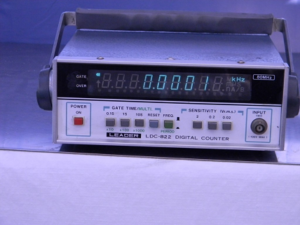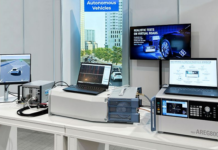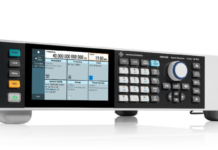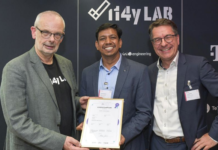
We are surrounded by systems working entirely off of radio signals. Radio frequency has applications in mobile phones, radios, Bluetooth, Wi-Fi, and 5G applications that power cloud computing, automotive technology, and the Internet of Things (IoT). Industries such as electronics, telecommunication, defense, industrial transportation, manufacturing, IT, and aerospace regularly rely on robust devices that transmit, receive, and analyze a slew of signals.
This makes the need for highly accurate digital frequency counters important. Digital frequency counters help test electronics by accurately measuring repetitive square and pulse signals, the time between edges of digital signals, and even act as timers. While selecting a digital frequency counter for test applications, it is important to look at parameters such as accuracy, resolution, and interval timers.
Types of Digital Frequency Counters
Selecting the type of digital frequency counter relevant to your application is crucial. Most frequency counters accumulate a set of events happening over a short period to carry out the analysis. Different types of counters include:
- Universal counters – As the name suggests, they measure a range of parameters such as frequency, time interval, oscillation, and pulses per second.
- RF frequency counters – These specialized test devices help measure precise frequencies up to 3 GHz and beyond.
- Microwave frequency counters – They help measure frequencies in the microwave range i.e. 40 GHz and beyond.
- Time interval analyzers – These are specifically designed to measure time intervals. It can continuously measure the period, pulse width, and time interval of signals that vary with time.
- Modulation domain analyzers – These are designed to show relative measurements of modulation quantities such as phase vs. time, frequency vs. time, and time interval vs. time.
All frequency counters can be segregated into two broad categories – direct counting frequency counters and reciprocal counting frequency counters.
- Direct counting frequency counters – These devices simply count cycles of signal over a period known as gate time and send the results to the counter’s display unit.
- Pros – Simple and inexpensive.
- Cons – The counter’s resolution is fixed in hertz and the accuracy may be lower than a reciprocal frequency counter. The speed of analysis may be slower.
- Reciprocal counting frequency counters – These devices measure and reciprocate the input signal’s period to find the frequency. This helps the counter’s resolution appear as a full number on digit displays.
- Pros – Faster and higher resolution measurements with a minimum amount of time.
- Cons – Comparatively expensive than direct counting frequency counters.
RF Frequency Counter Applications
Radio Frequency (RF) counters are widely used in the mobile telecom domain as it is driven by RF and microwave engineering. Its testing applications include measurement of the following in RF range:
- Frequency of the pulse produced by a square wave generator.
- Frequencies of the outgoing signal at the transmitter and incoming signal at the receiver.
- Data transmissions due to clock pulses.
- High power data transmitters and oscillators.
- Devices with steady repetitive signals.
Counter Accuracy vs. Resolution & Errors
Counters are easy to operate. You simply plug in the signal input and the display will show the frequency and other parameters. Though it is important to pay attention to how you set up the counter to get the best results. Test engineers often equate higher resolution of display reading to greater accuracy.
But that isn’t necessarily true.
Resolution is essentially the smallest variation that a digital counter can detect. A higher number of digits signifies higher resolution. However, it can only be accurate if other errors do not disrupt the counter’s measuring capability. The measurement disruptors can be classified into random and systematic errors.
Random errors include:
- Quantization error – There can be a minor non-coherence between the input signal and internal clock frequency of the counter. This can cause a +/- 1 count ambiguity in the least significant digit.
- Trigger error – Any noise in the input channels of the counter or input signal can cause a trigger error in the measurements.
- Timebase error – Digital counter measurement can be affected by any difference between the actual time base oscillator frequency and its nominal frequency.
Systematic errors can creep in due to external factors that may not be in control of the operator. It can cause biases in the measurement system that deviates the readings away from actual frequency. Factors that cause systematic errors include aging, temperature variations, and line voltage variations.
Systematic and random errors are inter-dependent. For example, Counter A with a high resolution but serious voltage variation can give inaccurate results. On the other hand, Counter B with smaller resolution and low systematic error can give better results.
Tips for Making Accurate Measurements Using Frequency Counters
Although there could always be minor variations in the output of a counter, the following steps can help avoid major errors:
- Choosing the right timebase – Timebase is the reference against which the counter measures the input signal. The better the timebase, the more accurate measurements will be. The quartz crystals vibrate at frequencies that are influenced by ambient temperatures. Following timebase technologies can help resolve this thermal behavior:
- Room Temperature Crystal Oscillator (RTXO) – This timebase does not depend on temperature compensation or control. They are designed to have a minimum effect on frequency over a range of temperatures – typically between 0 and 50 degrees Celsius.
- Temperature Compensated Crystal Oscillator (TCXO) – This method adds external components that counter thermal variations and obtain a stable frequency.
- Oven Controlled Crystal Oscillator (OCXO) – With this method, the crystal oscillator is housed inside an oven that holds the temperature stable thus giving an accurate timebase.
- Use the best arming mode – A typical digital counter has four arming modes – automatic, external, time, and digits. While automatic arming mode is the fastest, it is also the most inaccurate. You can improve the resolution by increasing gate time with external, digit, or time arming modes.
- Monitor trigger level timing error – Resolution, accuracy, the fidelity of the input amplifier, slew rate of the input signal, and width of the input hysteresis band are some of the factors while making timing measurements such as time interval, pulse width, rise time, fall time, phase, and duty cycle. To get better measurements, trigger at the offset value of the sine wave or square wave signal.
- Lock all timebases to a single clock – Using independent time bases can introduce skew and jitter.
- Setting the counter to a known state – After sending a reset command, it is advisable to add a wait or delay of 1 second to the program for the instrument to come back to a steady-state.
- Avoid noise triggers – Noisy signals can result in the counter triggering to spurious zero crossings causing inaccurate measurements. High-quality counters allow you to adjust the band to avoid unwanted triggering.
- Improve low-frequency measurements – Some of the steps you can follow to improve the measurements are:
- Utilize low pass filter
- Use manual triggering
- Use DC coupling
- Decrease the counter’s sensitivity
- Monitor the status register.
- Use limit testing – The readings shown by a counter can be 10 – 12 digits long, and they can change every second. One easy way to interpret the readings easily is to set a limit beyond which the counter will stop taking the readings.
Conclusion
With any measuring instrument, getting accurate readings is the key to testing and development activities. If signal measurement and analysis are crucial in your line of work, you must stay in the know about the latest in test equipment development. You should also enable access to the best-in-budget frequency counters out there for your teams.
While digital frequency counters are simple instruments, engineers can arm themselves with additional knowledge on how to use the device and get accurate results results by referring to the tips mentioned above.



















